BTEC Level 5 HND Computing Unit 2: Networking Principles Report
VerifiedAdded on 2020/11/30
|68
|8283
|427
Report
AI Summary
This report delves into the core principles of networking, encompassing an examination of networking principles, protocols, and devices, along with the advantages and disadvantages of various network solutions. The report thoroughly analyzes the influence of network topology, communication methods, and bandwidth requirements, evaluating the efficacy of different networking systems. It provides detailed explanations of the operational dynamics of networking devices and server types, and it discusses the importance of networking software. The report also covers the OSI and TCP/IP models, various network topologies (STAR, RING, BUS), and the impact of network structure, communication, and bandwidth. The report further explores the design of efficient networked systems, including VLAN, DHCP, static routing, NAT, and ACL configurations. Finally, it presents the implementation and diagnosis of networked systems, alongside test results and potential improvements.
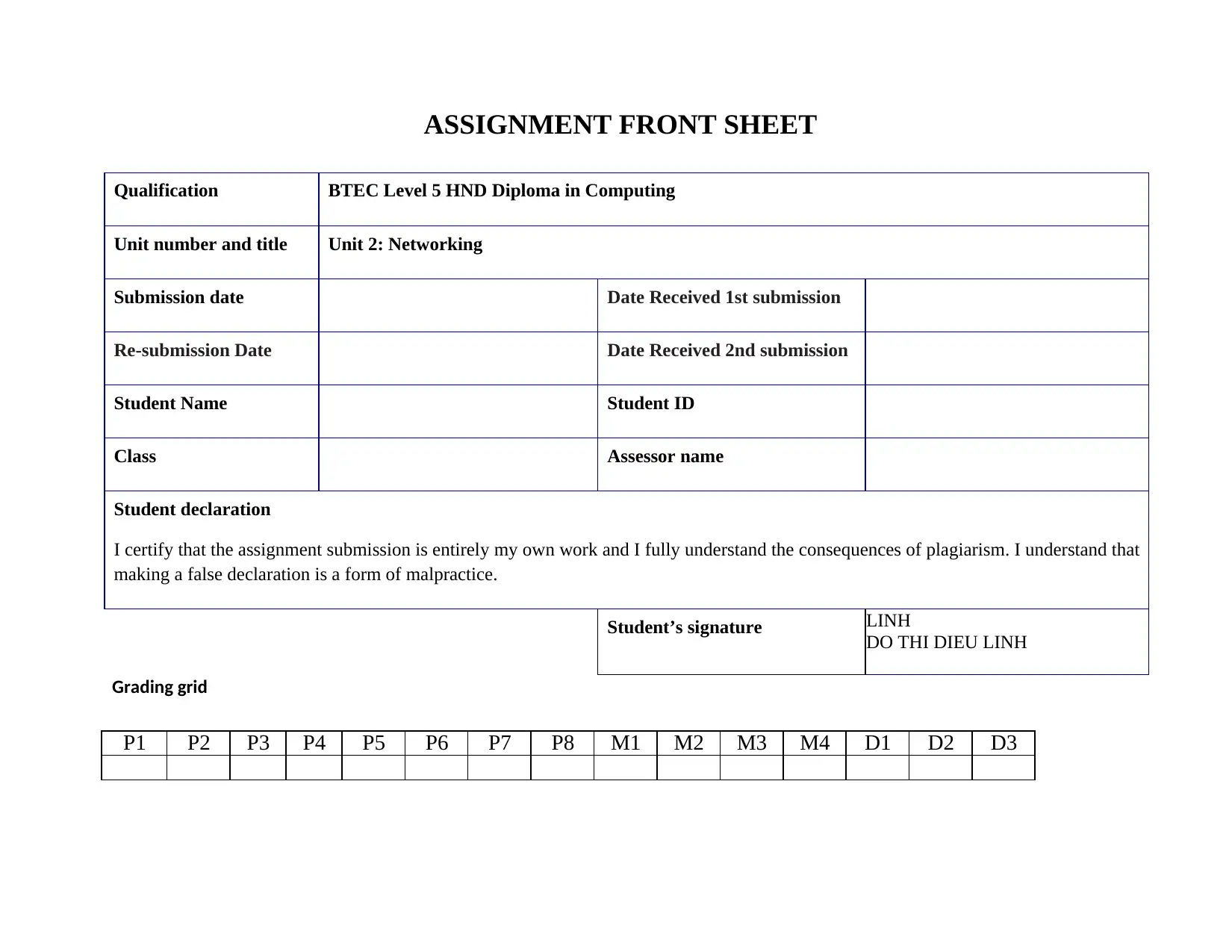
ASSIGNMENT FRONT SHEET
Qualification BTEC Level 5 HND Diploma in Computing
Unit number and title Unit 2: Networking
Submission date Date Received 1st submission
Re-submission Date Date Received 2nd submission
Student Name Student ID
Class Assessor name
Student declaration
I certify that the assignment submission is entirely my own work and I fully understand the consequences of plagiarism. I understand that
making a false declaration is a form of malpractice.
Student’s signature LINH
DO THI DIEU LINH
Grading grid
P1 P2 P3 P4 P5 P6 P7 P8 M1 M2 M3 M4 D1 D2 D3
Qualification BTEC Level 5 HND Diploma in Computing
Unit number and title Unit 2: Networking
Submission date Date Received 1st submission
Re-submission Date Date Received 2nd submission
Student Name Student ID
Class Assessor name
Student declaration
I certify that the assignment submission is entirely my own work and I fully understand the consequences of plagiarism. I understand that
making a false declaration is a form of malpractice.
Student’s signature LINH
DO THI DIEU LINH
Grading grid
P1 P2 P3 P4 P5 P6 P7 P8 M1 M2 M3 M4 D1 D2 D3
Paraphrase This Document
Need a fresh take? Get an instant paraphrase of this document with our AI Paraphraser
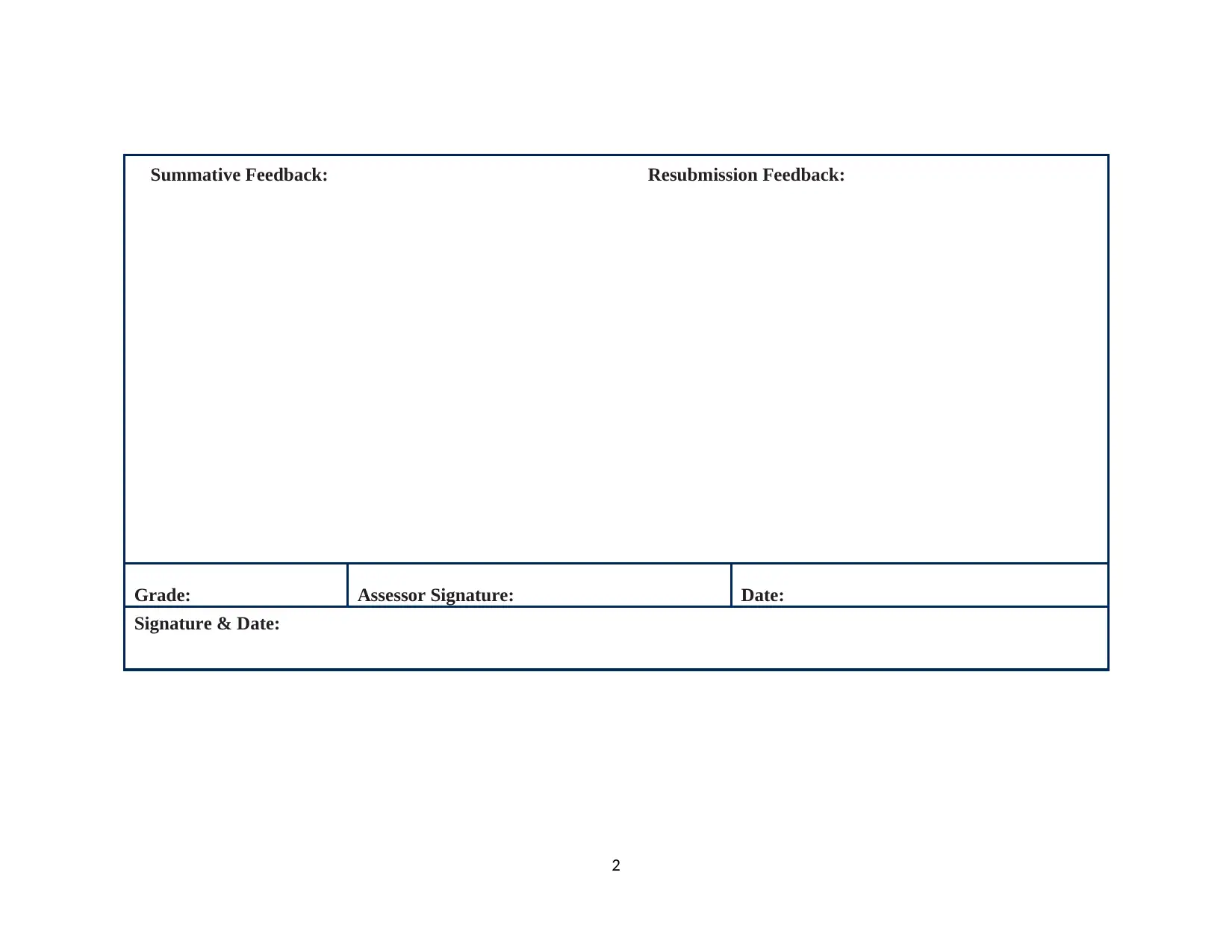
Summative Feedback: Resubmission Feedback:
Grade: Assessor Signature: Date:
Signature & Date:
2
Grade: Assessor Signature: Date:
Signature & Date:
2

3
⊘ This is a preview!⊘
Do you want full access?
Subscribe today to unlock all pages.

Trusted by 1+ million students worldwide
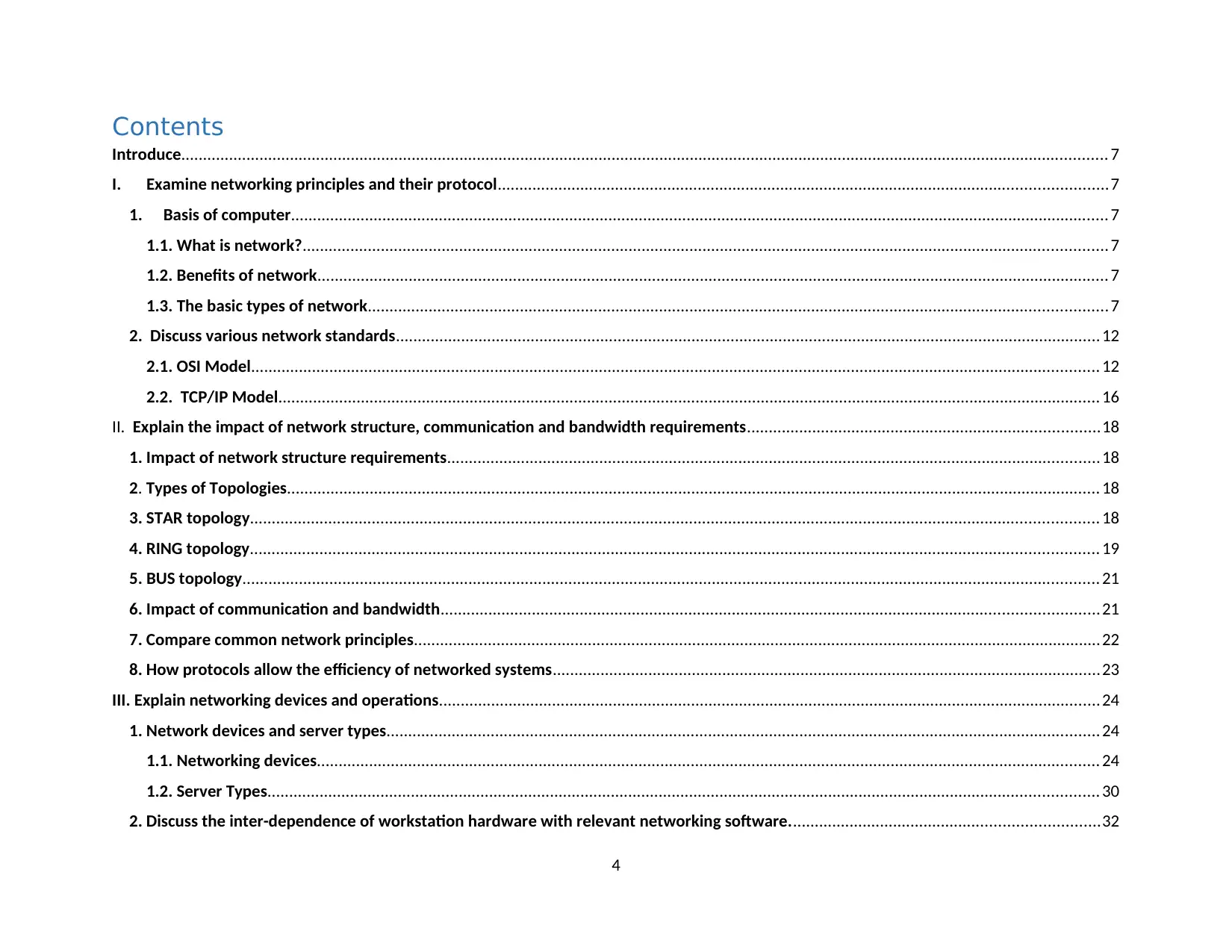
Contents
Introduce..................................................................................................................................................................................................................... 7
I. Examine networking principles and their protocol............................................................................................................................................7
1. Basis of computer............................................................................................................................................................................................ 7
1.1. What is network?......................................................................................................................................................................................... 7
1.2. Benefits of network...................................................................................................................................................................................... 7
1.3. The basic types of network..........................................................................................................................................................................7
2. Discuss various network standards..................................................................................................................................................................12
2.1. OSI Model................................................................................................................................................................................................... 12
2.2. TCP/IP Model............................................................................................................................................................................................. 16
II. Explain the impact of network structure, communication and bandwidth requirements.................................................................................18
1. Impact of network structure requirements......................................................................................................................................................18
2. Types of Topologies........................................................................................................................................................................................... 18
3. STAR topology................................................................................................................................................................................................... 18
4. RING topology................................................................................................................................................................................................... 19
5. BUS topology..................................................................................................................................................................................................... 21
6. Impact of communication and bandwidth.......................................................................................................................................................21
7. Compare common network principles..............................................................................................................................................................22
8. How protocols allow the efficiency of networked systems..............................................................................................................................23
III. Explain networking devices and operations........................................................................................................................................................24
1. Network devices and server types....................................................................................................................................................................24
1.1. Networking devices.................................................................................................................................................................................... 24
1.2. Server Types............................................................................................................................................................................................... 30
2. Discuss the inter-dependence of workstation hardware with relevant networking software.......................................................................32
4
Introduce..................................................................................................................................................................................................................... 7
I. Examine networking principles and their protocol............................................................................................................................................7
1. Basis of computer............................................................................................................................................................................................ 7
1.1. What is network?......................................................................................................................................................................................... 7
1.2. Benefits of network...................................................................................................................................................................................... 7
1.3. The basic types of network..........................................................................................................................................................................7
2. Discuss various network standards..................................................................................................................................................................12
2.1. OSI Model................................................................................................................................................................................................... 12
2.2. TCP/IP Model............................................................................................................................................................................................. 16
II. Explain the impact of network structure, communication and bandwidth requirements.................................................................................18
1. Impact of network structure requirements......................................................................................................................................................18
2. Types of Topologies........................................................................................................................................................................................... 18
3. STAR topology................................................................................................................................................................................................... 18
4. RING topology................................................................................................................................................................................................... 19
5. BUS topology..................................................................................................................................................................................................... 21
6. Impact of communication and bandwidth.......................................................................................................................................................21
7. Compare common network principles..............................................................................................................................................................22
8. How protocols allow the efficiency of networked systems..............................................................................................................................23
III. Explain networking devices and operations........................................................................................................................................................24
1. Network devices and server types....................................................................................................................................................................24
1.1. Networking devices.................................................................................................................................................................................... 24
1.2. Server Types............................................................................................................................................................................................... 30
2. Discuss the inter-dependence of workstation hardware with relevant networking software.......................................................................32
4
Paraphrase This Document
Need a fresh take? Get an instant paraphrase of this document with our AI Paraphraser
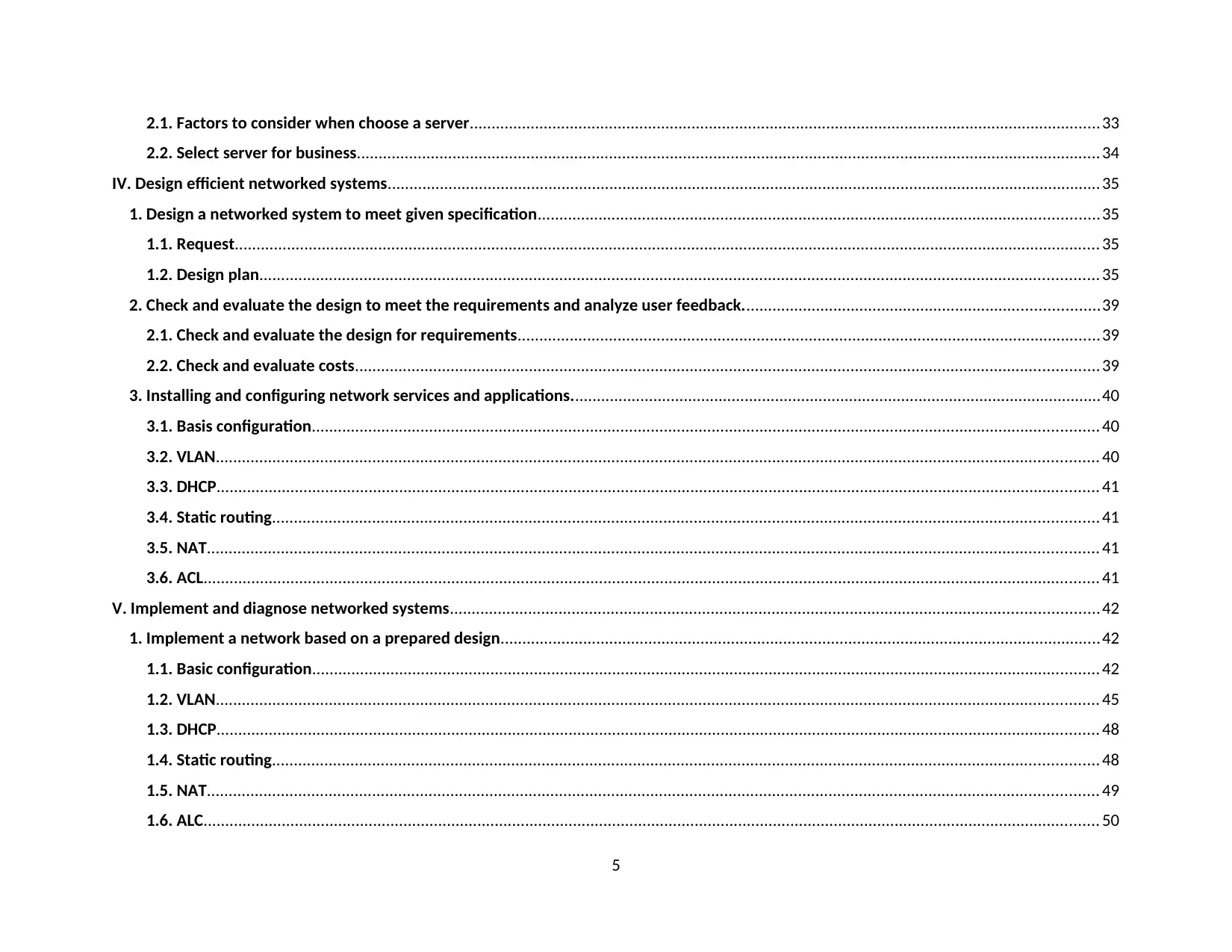
2.1. Factors to consider when choose a server.................................................................................................................................................33
2.2. Select server for business........................................................................................................................................................................... 34
IV. Design efficient networked systems....................................................................................................................................................................35
1. Design a networked system to meet given specification.................................................................................................................................35
1.1. Request....................................................................................................................................................................................................... 35
1.2. Design plan................................................................................................................................................................................................. 35
2. Check and evaluate the design to meet the requirements and analyze user feedback..................................................................................39
2.1. Check and evaluate the design for requirements......................................................................................................................................39
2.2. Check and evaluate costs........................................................................................................................................................................... 39
3. Installing and configuring network services and applications..........................................................................................................................40
3.1. Basis configuration..................................................................................................................................................................................... 40
3.2. VLAN........................................................................................................................................................................................................... 40
3.3. DHCP........................................................................................................................................................................................................... 41
3.4. Static routing.............................................................................................................................................................................................. 41
3.5. NAT............................................................................................................................................................................................................. 41
3.6. ACL.............................................................................................................................................................................................................. 41
V. Implement and diagnose networked systems.....................................................................................................................................................42
1. Implement a network based on a prepared design..........................................................................................................................................42
1.1. Basic configuration..................................................................................................................................................................................... 42
1.2. VLAN........................................................................................................................................................................................................... 45
1.3. DHCP........................................................................................................................................................................................................... 48
1.4. Static routing.............................................................................................................................................................................................. 48
1.5. NAT............................................................................................................................................................................................................. 49
1.6. ALC.............................................................................................................................................................................................................. 50
5
2.2. Select server for business........................................................................................................................................................................... 34
IV. Design efficient networked systems....................................................................................................................................................................35
1. Design a networked system to meet given specification.................................................................................................................................35
1.1. Request....................................................................................................................................................................................................... 35
1.2. Design plan................................................................................................................................................................................................. 35
2. Check and evaluate the design to meet the requirements and analyze user feedback..................................................................................39
2.1. Check and evaluate the design for requirements......................................................................................................................................39
2.2. Check and evaluate costs........................................................................................................................................................................... 39
3. Installing and configuring network services and applications..........................................................................................................................40
3.1. Basis configuration..................................................................................................................................................................................... 40
3.2. VLAN........................................................................................................................................................................................................... 40
3.3. DHCP........................................................................................................................................................................................................... 41
3.4. Static routing.............................................................................................................................................................................................. 41
3.5. NAT............................................................................................................................................................................................................. 41
3.6. ACL.............................................................................................................................................................................................................. 41
V. Implement and diagnose networked systems.....................................................................................................................................................42
1. Implement a network based on a prepared design..........................................................................................................................................42
1.1. Basic configuration..................................................................................................................................................................................... 42
1.2. VLAN........................................................................................................................................................................................................... 45
1.3. DHCP........................................................................................................................................................................................................... 48
1.4. Static routing.............................................................................................................................................................................................. 48
1.5. NAT............................................................................................................................................................................................................. 49
1.6. ALC.............................................................................................................................................................................................................. 50
5
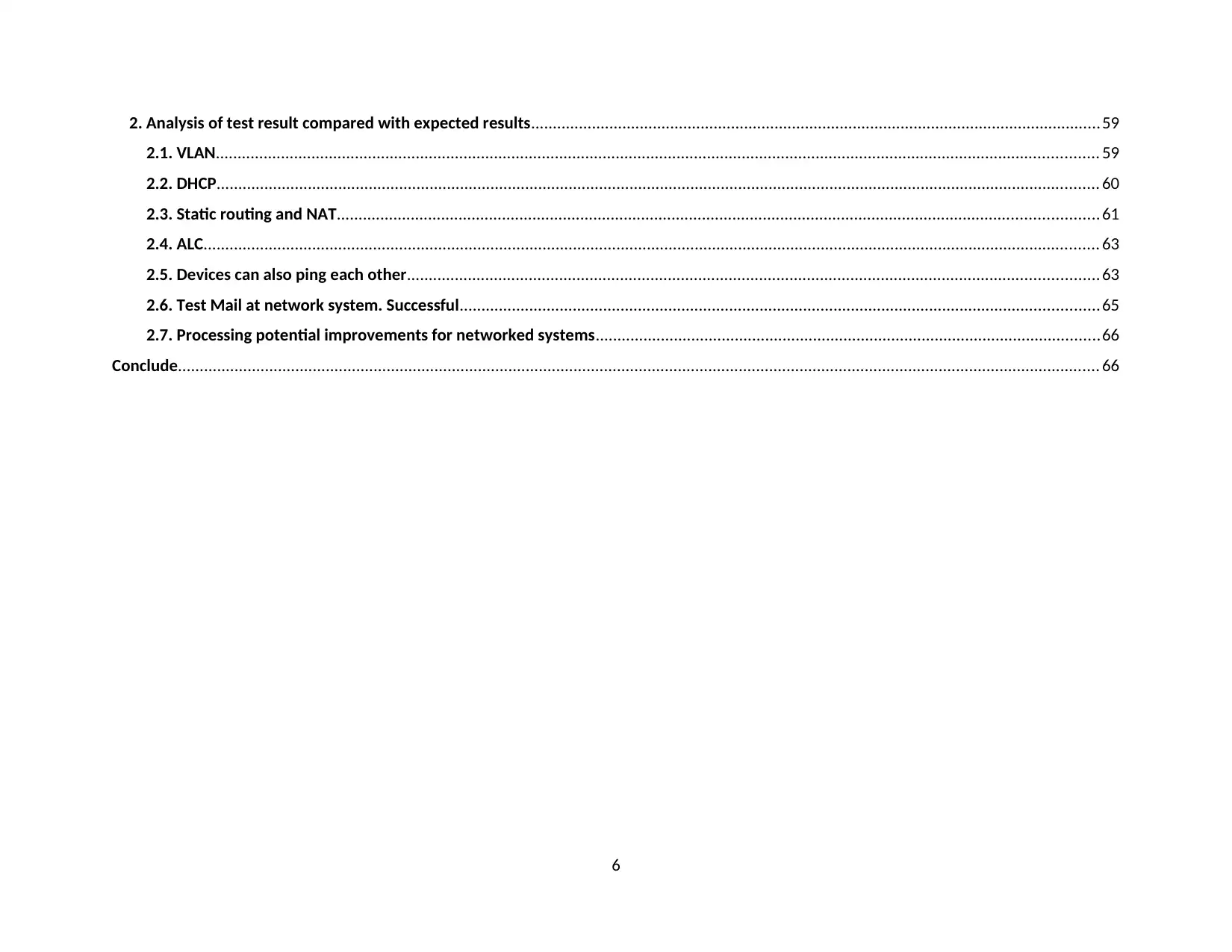
2. Analysis of test result compared with expected results...................................................................................................................................59
2.1. VLAN........................................................................................................................................................................................................... 59
2.2. DHCP........................................................................................................................................................................................................... 60
2.3. Static routing and NAT............................................................................................................................................................................... 61
2.4. ALC.............................................................................................................................................................................................................. 63
2.5. Devices can also ping each other...............................................................................................................................................................63
2.6. Test Mail at network system. Successful...................................................................................................................................................65
2.7. Processing potential improvements for networked systems....................................................................................................................66
Conclude.................................................................................................................................................................................................................... 66
6
2.1. VLAN........................................................................................................................................................................................................... 59
2.2. DHCP........................................................................................................................................................................................................... 60
2.3. Static routing and NAT............................................................................................................................................................................... 61
2.4. ALC.............................................................................................................................................................................................................. 63
2.5. Devices can also ping each other...............................................................................................................................................................63
2.6. Test Mail at network system. Successful...................................................................................................................................................65
2.7. Processing potential improvements for networked systems....................................................................................................................66
Conclude.................................................................................................................................................................................................................... 66
6
⊘ This is a preview!⊘
Do you want full access?
Subscribe today to unlock all pages.

Trusted by 1+ million students worldwide
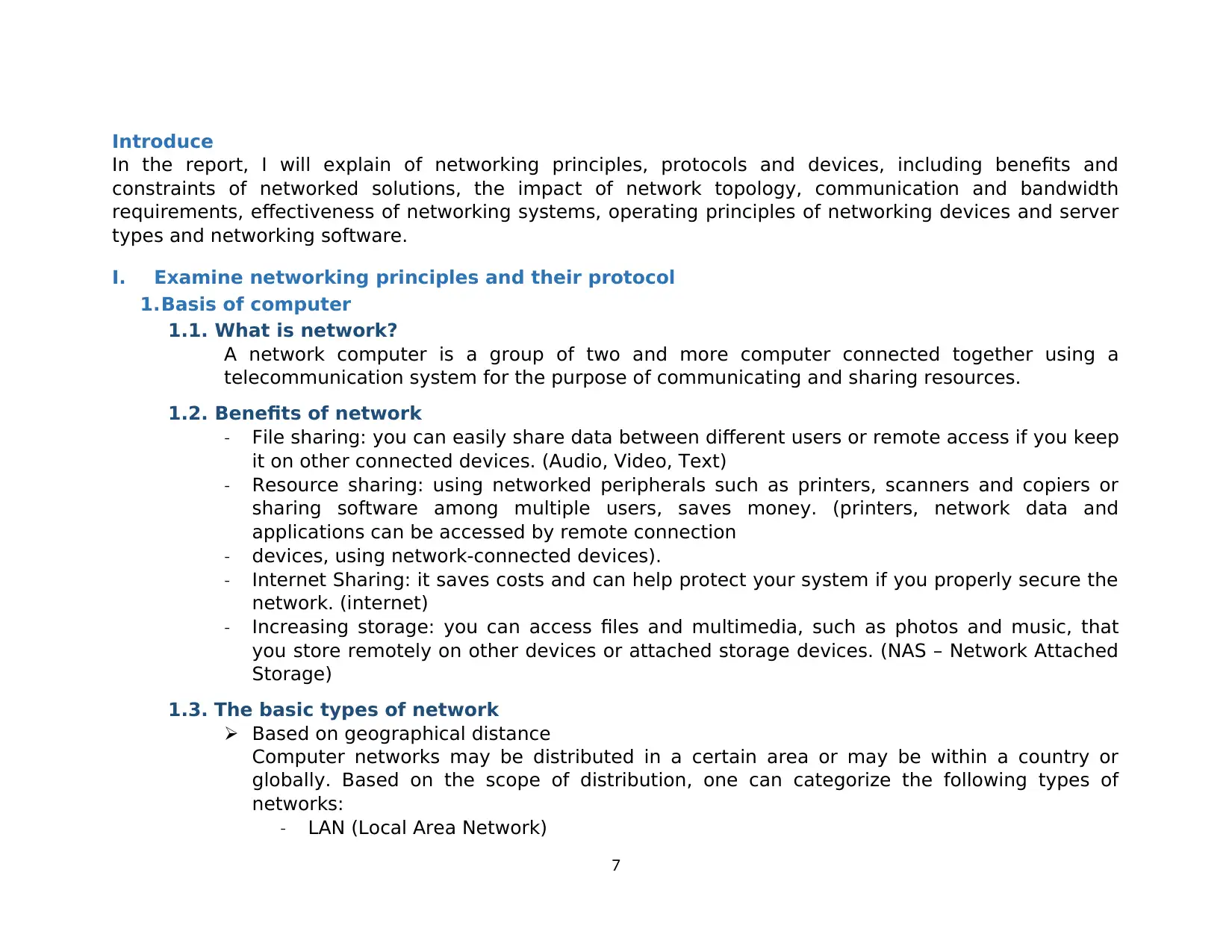
Introduce
In the report, I will explain of networking principles, protocols and devices, including benefits and
constraints of networked solutions, the impact of network topology, communication and bandwidth
requirements, effectiveness of networking systems, operating principles of networking devices and server
types and networking software.
I. Examine networking principles and their protocol
1.Basis of computer
1.1. What is network?
A network computer is a group of two and more computer connected together using a
telecommunication system for the purpose of communicating and sharing resources.
1.2. Benefits of network
- File sharing: you can easily share data between different users or remote access if you keep
it on other connected devices. (Audio, Video, Text)
- Resource sharing: using networked peripherals such as printers, scanners and copiers or
sharing software among multiple users, saves money. (printers, network data and
applications can be accessed by remote connection
- devices, using network-connected devices).
- Internet Sharing: it saves costs and can help protect your system if you properly secure the
network. (internet)
- Increasing storage: you can access files and multimedia, such as photos and music, that
you store remotely on other devices or attached storage devices. (NAS – Network Attached
Storage)
1.3. The basic types of network
Based on geographical distance
Computer networks may be distributed in a certain area or may be within a country or
globally. Based on the scope of distribution, one can categorize the following types of
networks:
- LAN (Local Area Network)
7
In the report, I will explain of networking principles, protocols and devices, including benefits and
constraints of networked solutions, the impact of network topology, communication and bandwidth
requirements, effectiveness of networking systems, operating principles of networking devices and server
types and networking software.
I. Examine networking principles and their protocol
1.Basis of computer
1.1. What is network?
A network computer is a group of two and more computer connected together using a
telecommunication system for the purpose of communicating and sharing resources.
1.2. Benefits of network
- File sharing: you can easily share data between different users or remote access if you keep
it on other connected devices. (Audio, Video, Text)
- Resource sharing: using networked peripherals such as printers, scanners and copiers or
sharing software among multiple users, saves money. (printers, network data and
applications can be accessed by remote connection
- devices, using network-connected devices).
- Internet Sharing: it saves costs and can help protect your system if you properly secure the
network. (internet)
- Increasing storage: you can access files and multimedia, such as photos and music, that
you store remotely on other devices or attached storage devices. (NAS – Network Attached
Storage)
1.3. The basic types of network
Based on geographical distance
Computer networks may be distributed in a certain area or may be within a country or
globally. Based on the scope of distribution, one can categorize the following types of
networks:
- LAN (Local Area Network)
7
Paraphrase This Document
Need a fresh take? Get an instant paraphrase of this document with our AI Paraphraser
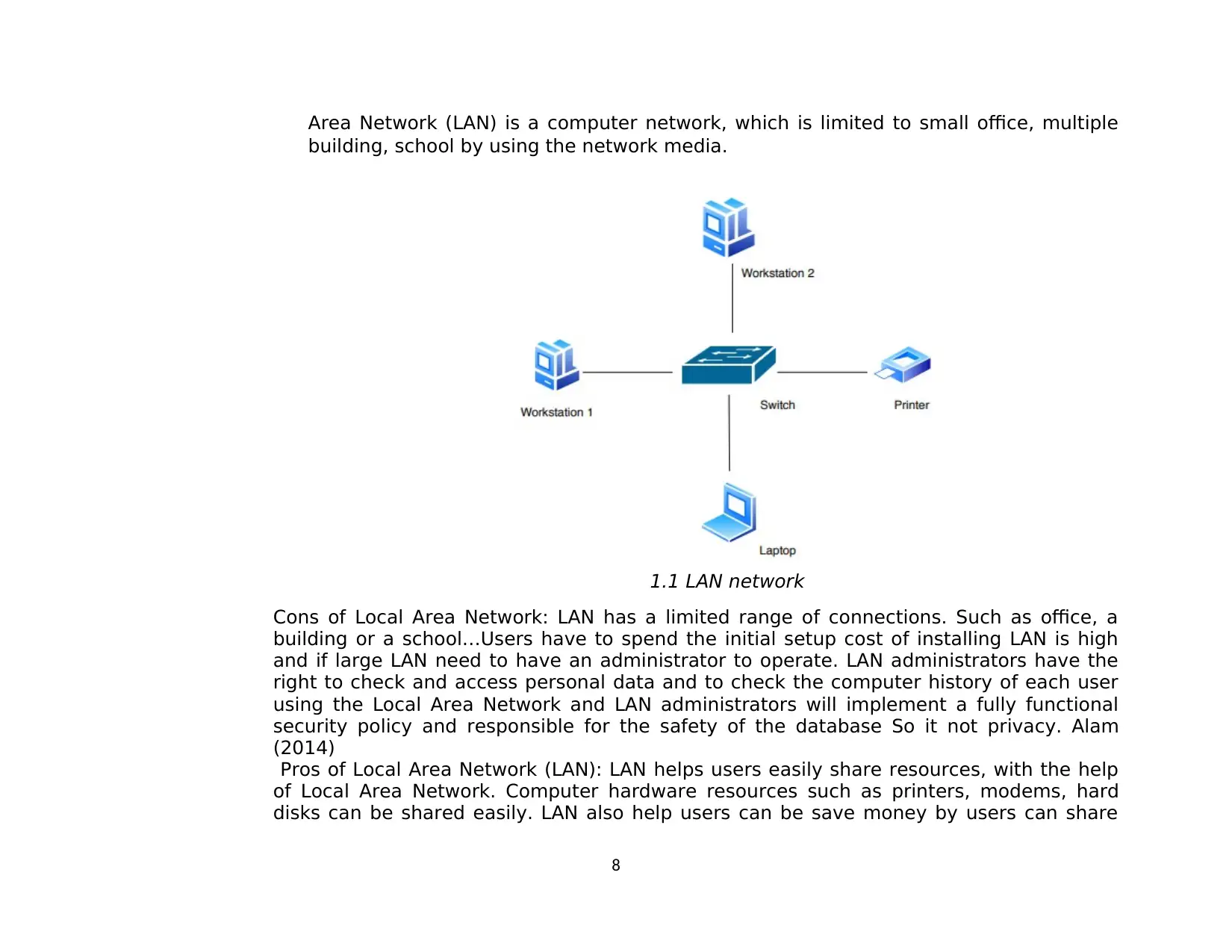
Area Network (LAN) is a computer network, which is limited to small office, multiple
building, school by using the network media.
1.1 LAN network
Cons of Local Area Network: LAN has a limited range of connections. Such as office, a
building or a school…Users have to spend the initial setup cost of installing LAN is high
and if large LAN need to have an administrator to operate. LAN administrators have the
right to check and access personal data and to check the computer history of each user
using the Local Area Network and LAN administrators will implement a fully functional
security policy and responsible for the safety of the database So it not privacy. Alam
(2014)
Pros of Local Area Network (LAN): LAN helps users easily share resources, with the help
of Local Area Network. Computer hardware resources such as printers, modems, hard
disks can be shared easily. LAN also help users can be save money by users can share
8
building, school by using the network media.
1.1 LAN network
Cons of Local Area Network: LAN has a limited range of connections. Such as office, a
building or a school…Users have to spend the initial setup cost of installing LAN is high
and if large LAN need to have an administrator to operate. LAN administrators have the
right to check and access personal data and to check the computer history of each user
using the Local Area Network and LAN administrators will implement a fully functional
security policy and responsible for the safety of the database So it not privacy. Alam
(2014)
Pros of Local Area Network (LAN): LAN helps users easily share resources, with the help
of Local Area Network. Computer hardware resources such as printers, modems, hard
disks can be shared easily. LAN also help users can be save money by users can share
8
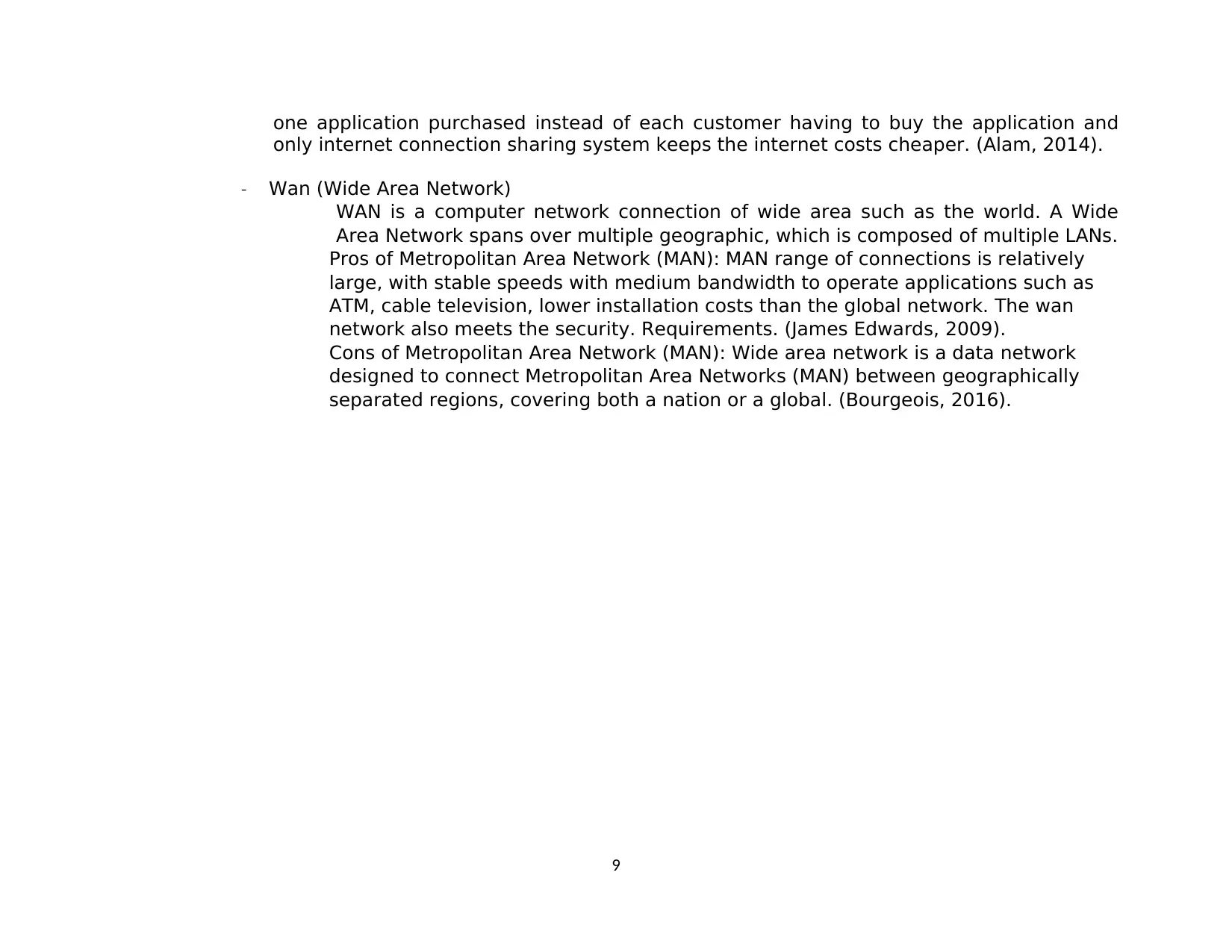
one application purchased instead of each customer having to buy the application and
only internet connection sharing system keeps the internet costs cheaper. (Alam, 2014).
- Wan (Wide Area Network)
WAN is a computer network connection of wide area such as the world. A Wide
Area Network spans over multiple geographic, which is composed of multiple LANs.
Pros of Metropolitan Area Network (MAN): MAN range of connections is relatively
large, with stable speeds with medium bandwidth to operate applications such as
ATM, cable television, lower installation costs than the global network. The wan
network also meets the security. Requirements. (James Edwards, 2009).
Cons of Metropolitan Area Network (MAN): Wide area network is a data network
designed to connect Metropolitan Area Networks (MAN) between geographically
separated regions, covering both a nation or a global. (Bourgeois, 2016).
9
only internet connection sharing system keeps the internet costs cheaper. (Alam, 2014).
- Wan (Wide Area Network)
WAN is a computer network connection of wide area such as the world. A Wide
Area Network spans over multiple geographic, which is composed of multiple LANs.
Pros of Metropolitan Area Network (MAN): MAN range of connections is relatively
large, with stable speeds with medium bandwidth to operate applications such as
ATM, cable television, lower installation costs than the global network. The wan
network also meets the security. Requirements. (James Edwards, 2009).
Cons of Metropolitan Area Network (MAN): Wide area network is a data network
designed to connect Metropolitan Area Networks (MAN) between geographically
separated regions, covering both a nation or a global. (Bourgeois, 2016).
9
⊘ This is a preview!⊘
Do you want full access?
Subscribe today to unlock all pages.

Trusted by 1+ million students worldwide
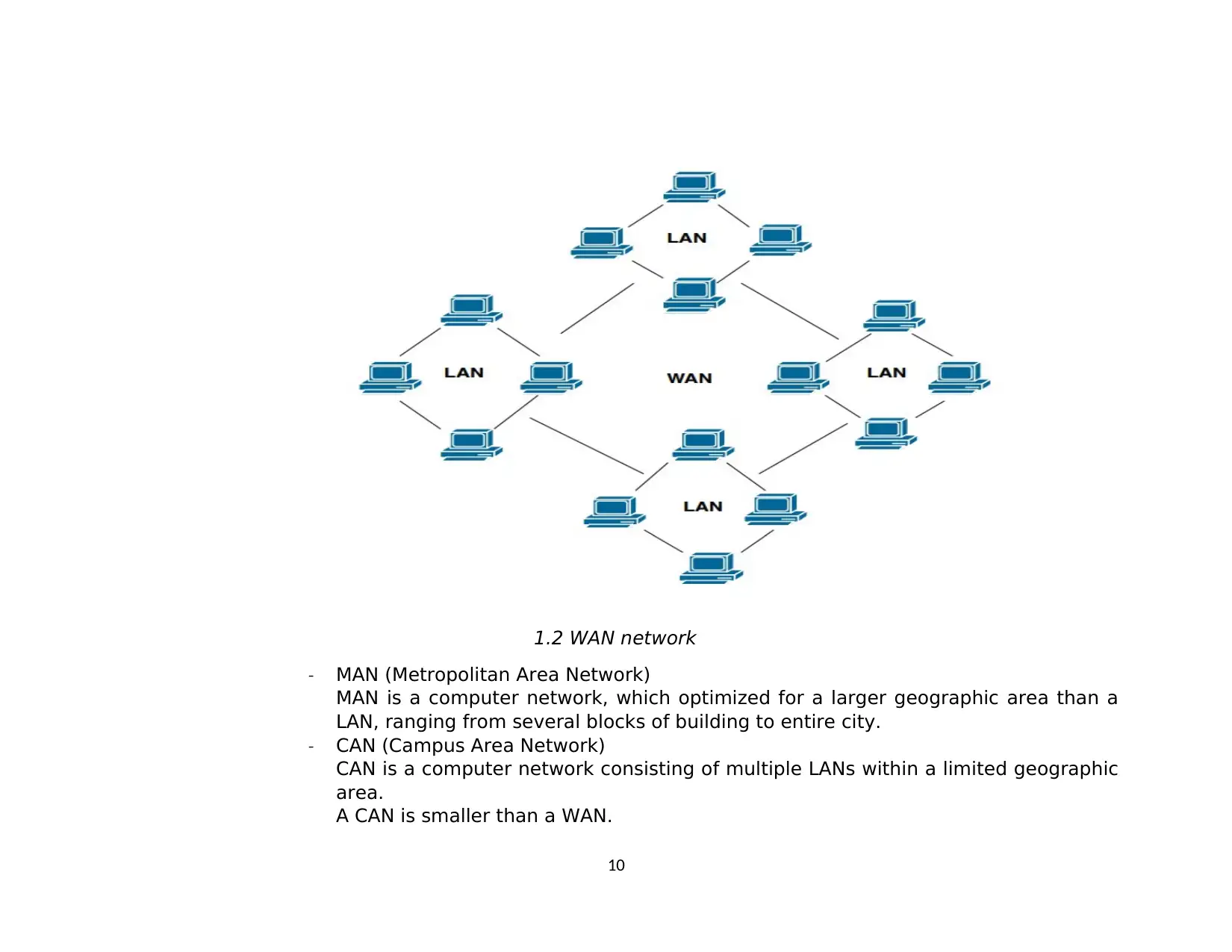
1.2 WAN network
- MAN (Metropolitan Area Network)
MAN is a computer network, which optimized for a larger geographic area than a
LAN, ranging from several blocks of building to entire city.
- CAN (Campus Area Network)
CAN is a computer network consisting of multiple LANs within a limited geographic
area.
A CAN is smaller than a WAN.
10
- MAN (Metropolitan Area Network)
MAN is a computer network, which optimized for a larger geographic area than a
LAN, ranging from several blocks of building to entire city.
- CAN (Campus Area Network)
CAN is a computer network consisting of multiple LANs within a limited geographic
area.
A CAN is smaller than a WAN.
10
Paraphrase This Document
Need a fresh take? Get an instant paraphrase of this document with our AI Paraphraser
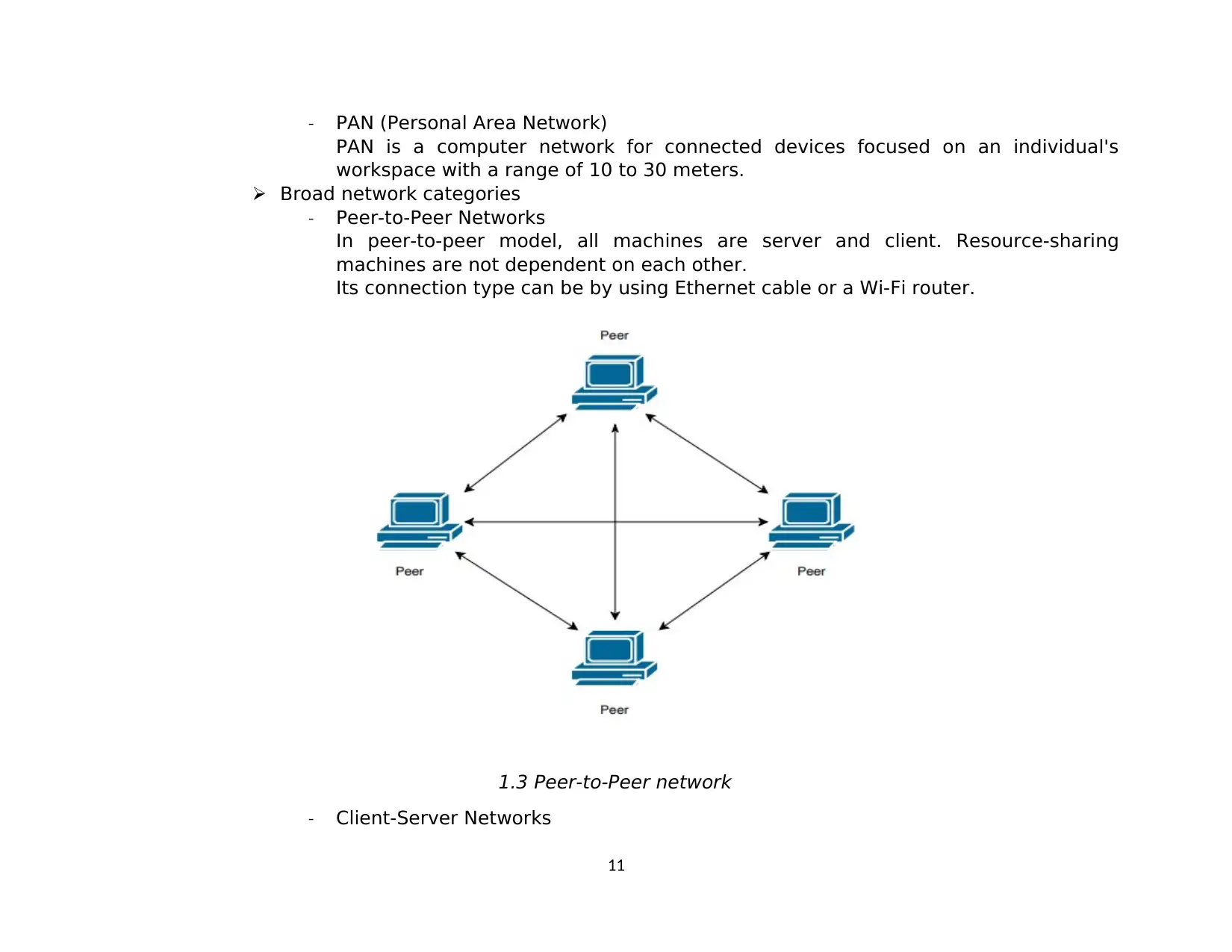
- PAN (Personal Area Network)
PAN is a computer network for connected devices focused on an individual's
workspace with a range of 10 to 30 meters.
Broad network categories
- Peer-to-Peer Networks
In peer-to-peer model, all machines are server and client. Resource-sharing
machines are not dependent on each other.
Its connection type can be by using Ethernet cable or a Wi-Fi router.
1.3 Peer-to-Peer network
- Client-Server Networks
11
PAN is a computer network for connected devices focused on an individual's
workspace with a range of 10 to 30 meters.
Broad network categories
- Peer-to-Peer Networks
In peer-to-peer model, all machines are server and client. Resource-sharing
machines are not dependent on each other.
Its connection type can be by using Ethernet cable or a Wi-Fi router.
1.3 Peer-to-Peer network
- Client-Server Networks
11
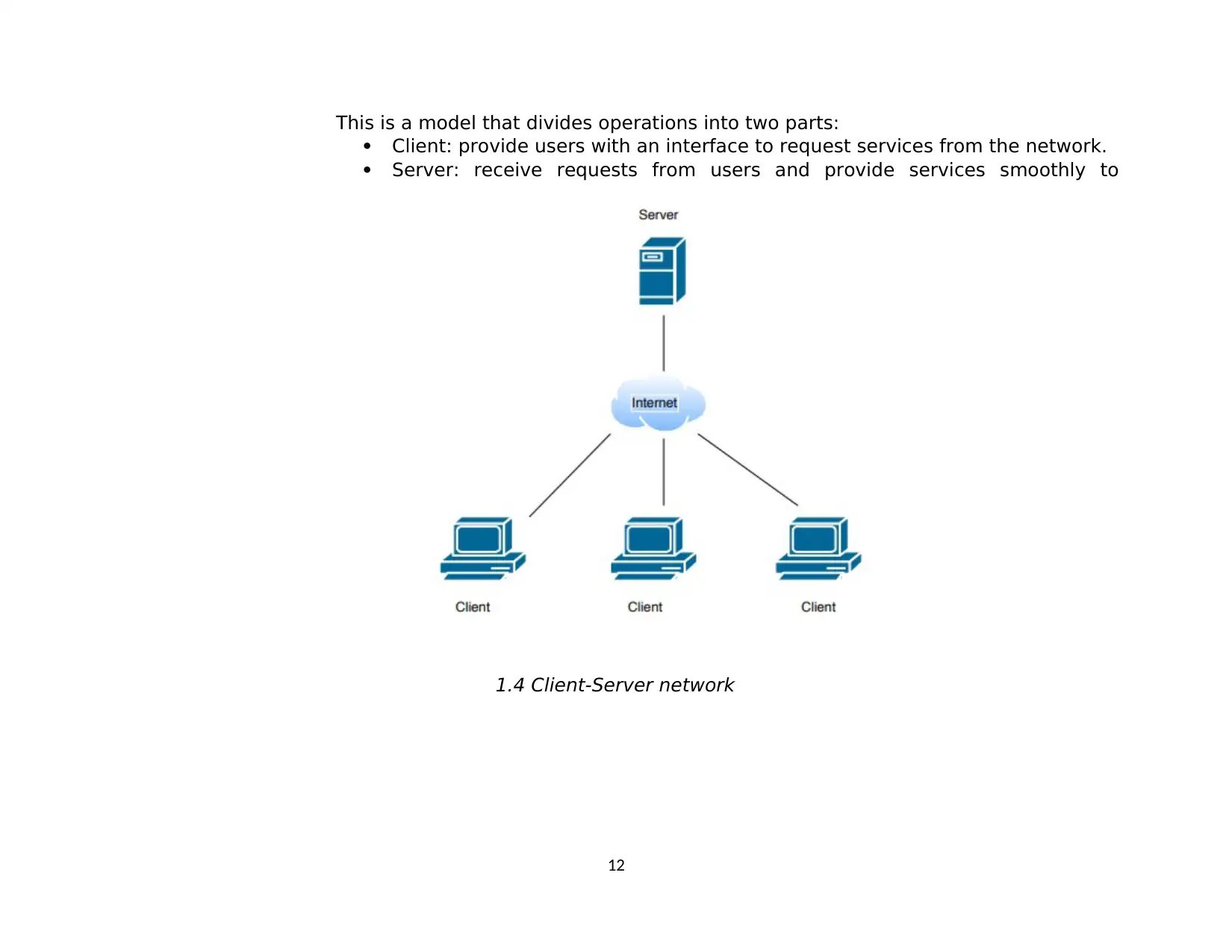
This is a model that divides operations into two parts:
Client: provide users with an interface to request services from the network.
Server: receive requests from users and provide services smoothly to
1.4 Client-Server network
12
Client: provide users with an interface to request services from the network.
Server: receive requests from users and provide services smoothly to
1.4 Client-Server network
12
⊘ This is a preview!⊘
Do you want full access?
Subscribe today to unlock all pages.

Trusted by 1+ million students worldwide
1 out of 68
Related Documents
Your All-in-One AI-Powered Toolkit for Academic Success.
+13062052269
info@desklib.com
Available 24*7 on WhatsApp / Email
![[object Object]](/_next/static/media/star-bottom.7253800d.svg)
Unlock your academic potential
Copyright © 2020–2025 A2Z Services. All Rights Reserved. Developed and managed by ZUCOL.



